Galaxies are categorized according to their visual morphology as elliptical, spiral, spiral barred or irregular. They are sometimes further divided into subcategories.
Key Facts & Summary
- There are four main categories of galaxies: elliptical, spiral, barred spiral, and irregular. These types of galaxies are further divided into subcategories while at the same time other types of galaxies exist based on their size and other unique features.
- The most common type of galaxy found throughout the universe is the spiral galaxy. Around 77% of the galaxies observed by man are spiral galaxies. A good example of this type is the Andromeda galaxy.
- Around two-thirds of all spiral galaxies have a bar-like structure – thus they are classified as barred spiral galaxies. Our galaxy, the Milky Way is an example of this type of galaxy.
- The rarest type of galaxies is the elliptical double-ringed galaxy. PGC 1000714 is an example. Estimates suggest that around 0.1% of galaxies are this type. It is sometimes named the Hoag-type galaxy.
- Elliptical galaxies are usually comprised of very old stars or stars with low mass. They make up around 10-15% of galaxies in the Virgo Supercluster, a supercluster of which we are also part of. They are very dim in comparison with the very bright spiral galaxies.
- Irregular galaxies are commonly small, and collectively they make up about a quarter of all the galaxies. They lack a distinct shape or form often having a chaotic appearance.
- The largest galaxies are usually giant elliptical galaxies, containing a trillion or even more stars. They span as much as one million light-years across – 10 times as much as the Milky Way.
- Curious enough, the smallest galaxies are also the elliptical types.
- The oldest and farthest galaxy ever discovered is an irregular type of galaxy called GN-z11. It is 32 billion light-years / 9.8 billion parsecs away from us. It is estimated that the galaxy formed just around 400 million years after the Big Bang.
- Most galaxies are between 1.000 to 100.000 parsecs / 3.000 to 300.000 light-years in diameter.
A system used by astronomers to divide galaxies into groups on their visual appearance is the galaxy morphological classification. Many schemes are in use in which galaxies are classified according to their morphologies. The most famous one is the Hubble sequence, devised by Edwin Hubble, and later expanded by Gerard Vaucouleurs and Allan Sandage.
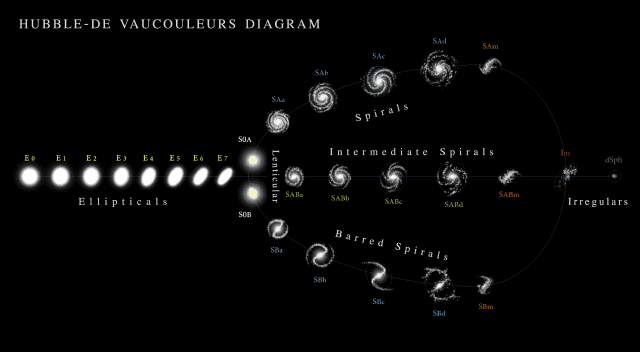
In the present day, galaxy classification and morphology are largely done using computational methods and physical morphology.
Originally, Edwin Hubble grouped galaxies into four main categories: spiral galaxies, barred spiral galaxies, elliptical galaxies, and irregular galaxies. Observations revealed that spiral galaxies were the most common type of galaxies found throughout the universe.
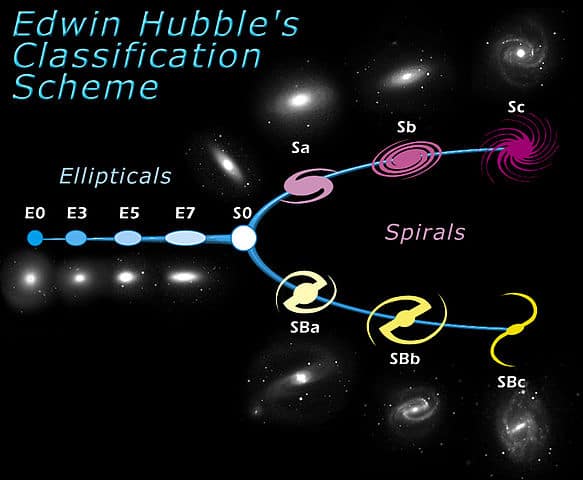
Spiral Galaxies
They have a flat, spinning disk with a central bulge surrounded by spiral arms. The spinning motion reaches speeds of up to hundreds of kilometers/miles per second. This usually can cause matter in the disk to take on a distinctive spiral shape, like a cosmic pinwheel. The bulge located in the center is made up of older, dimmer stars, and is thought to usually contain a supermassive black hole.

The disk of stars orbiting the bulge tends to separate into arms that circle the galaxy. These spiral arms contain a wealth of gas and dust, thus many young stars are birthed in these regions. These young stars shine very brightly before their quick demise. Spiral galaxies can be classified according to the tightness of their spiral, the lumpiness of their arms, and the overall size of their central bulge.
The relative amounts of gas and dust contained within these galaxies can portray these differences. Andromeda is a perfect example of a spiral galaxy.
Elliptical Galaxies
Elliptical galaxies have an elongated spherical shape and lack a nucleus or bulge at the center. Although there is no nucleus, the galaxy is still brighter in the center and becomes less bright toward the outer edges of the galaxy.
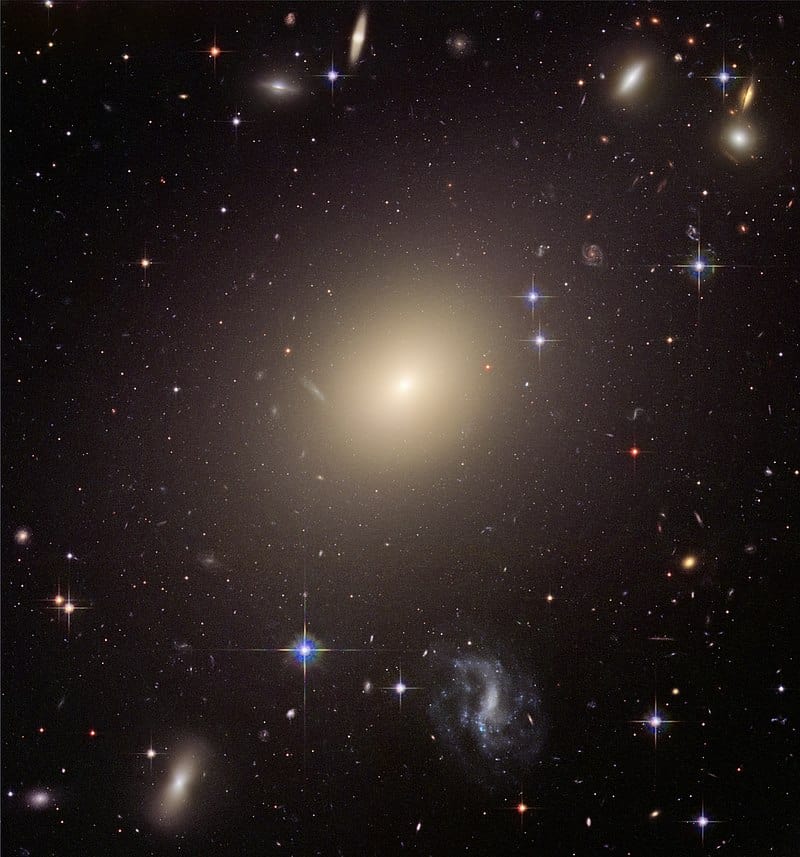
Their light is dominated by older reddish stars. They appear to also lack spiral arms. The stars, gases and other materials are spread throughout an elliptical galaxy. Elliptical galaxies can be nearly round or long and cigar-shaped.
Though individual stars orbit the center of an elliptical galaxy, the orbits aren’t all in the same direction, as they appear in spirals. Therefore, ellipticals don’t appear to rotate in a systematic way
Theories suggest that a great deal of the mass in an elliptical galaxy is due to the presence of a central black hole. Elliptical galaxies have very little activity and contain mostly old stars of low mass, because there gasses and dust which is needed to form new stars, is quite lacking.
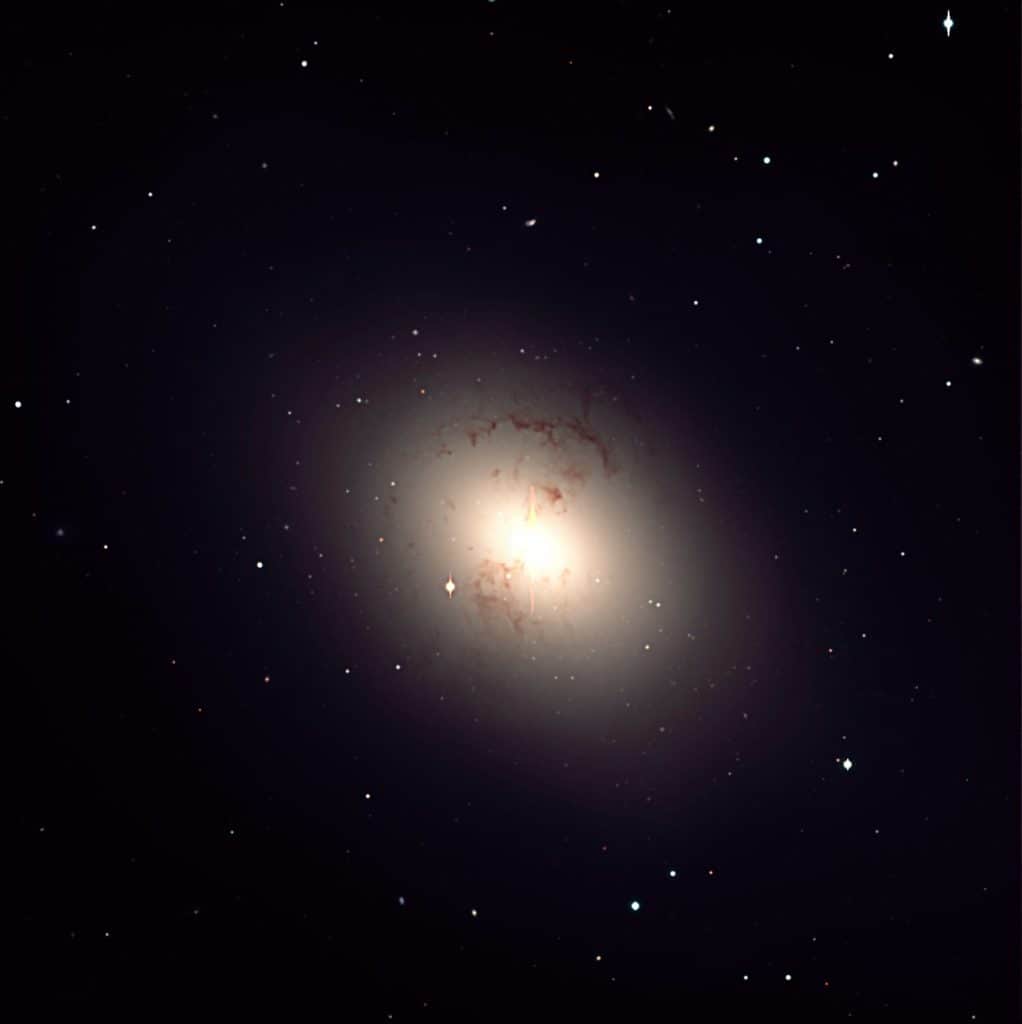
Elliptical galaxies vary in size, from small dwarf galaxies to enormous galaxies. An example of a giant elliptical galaxy is ESO 325-G004, while Leo I is a dwarf elliptical galaxy. An intermediate between the giant and dwarf elliptical galaxies are systems such as M32 and M110, they are companions of the Andromeda galaxy.
Irregular Galaxies
Irregular galaxies have no definite shape, though they are in constant motion like all other galaxies. They have a chaotic appearance as they don’t seem to possess a nuclear bulge or traces of spiral arms.
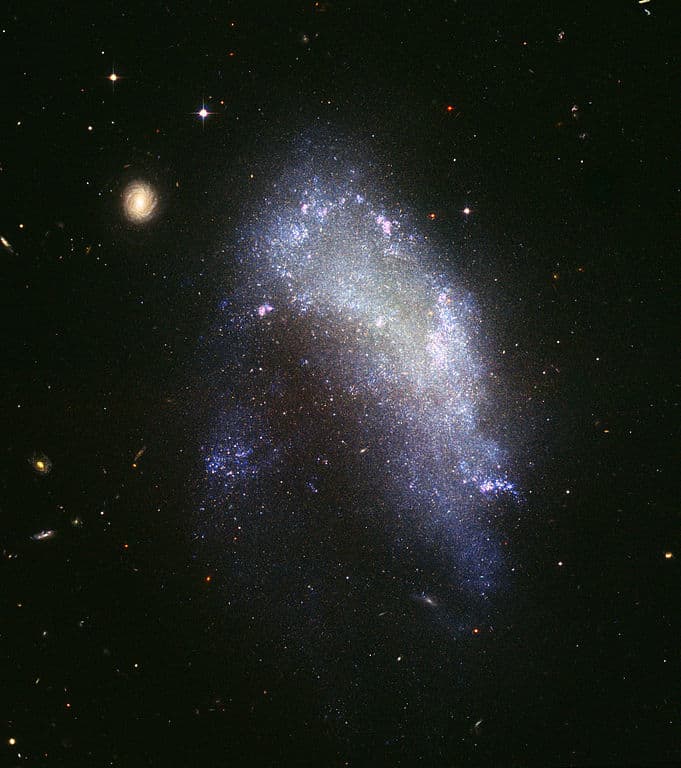
Some irregular galaxies were once spiral or elliptical galaxies but were deformed by an uneven external gravitational force. Irregular galaxies may contain abundant amounts of gas and dust Irregular galaxies are commonly small, about one-tenth the mass of the Milky Way galaxy.
Until now, three major types of irregular galaxies have been established:
- Irr I – they feature some structure but not enough to be placed into the Hubble sequence.
- Irr II – they do not appear to feature any structure.
- DIrr III – dwarf irregular galaxy. They tend to have low metallicity and relatively high levels of gas. They are also believed to be similar to the earliest galaxies that populated the Universe.
Irregular galaxies can be distorted by the gravity of a larger neighbor, a good example of this are the Large and Small Magellanic Clouds, distorted by our Milky Way.
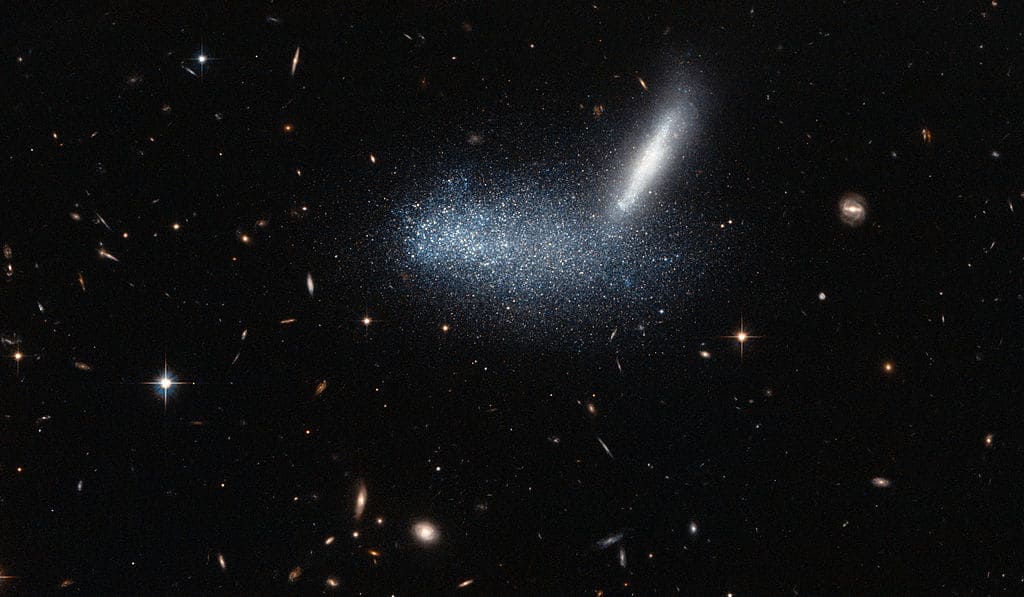
Barred Spiral Galaxies
Barred spiral galaxies share the same features and functions as regular spiral galaxies, but they also have a bar of bright stars that lie along the center of the bulge and extend into the disk. The bright bulge has very little activity here and contains mostly older, red stars. The bar and arms have lots of activity, including star formation.
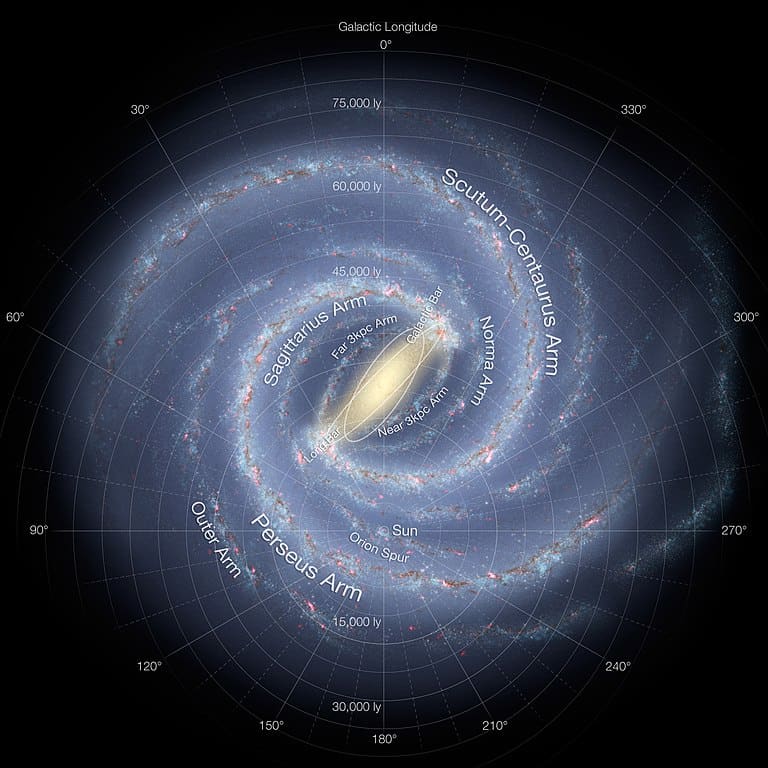
The perfect example of a barred spiral galaxy is our own galaxy, the Milky Way. They are further divided into three categories:
- Barred spiral galaxy type A – abbreviation SBa – they feature tightly bound arms.
- Barred spiral galaxy type B – abbreviation SBb – they feature both tightly and loosely bond arms.
- Barred spiral galaxy type C – abbreviation Sbc – they have loosely bound arms.
Around two-thirds of spiral galaxies contain a bar structure through their center.
Other types of Galaxies
Some galaxies have a ring-like structure of stars and interstellar medium surrounding a bare core. It is believed that they take this shape when smaller galaxies pass through the core of spiral galaxies.
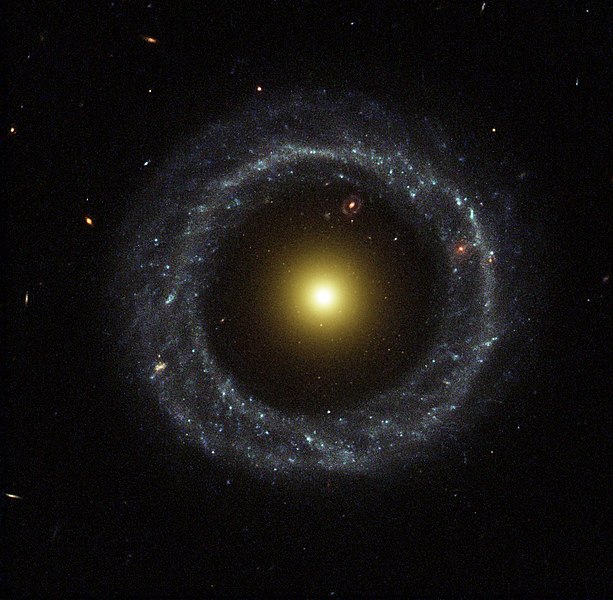
Lenticular galaxies are a type of galaxy that shares similarities with both spiral and elliptical galaxies. They possess ill-defined spiral arms with an elliptical halo of stars.
Some galaxies are classified as ultra-diffuse galaxies – they have extremely low densities. They may be as big as our Milky Way yet the visible star count typically is around 1%. This is attributed to a lack of star-forming gas.
On the other end, there are starburst galaxies that are characterized by dusty concentrations of gas and the appearance of newly formed stars. Usually, many of these stars are massive and result in supernova explosions that interact powerfully with the surrounding gas.
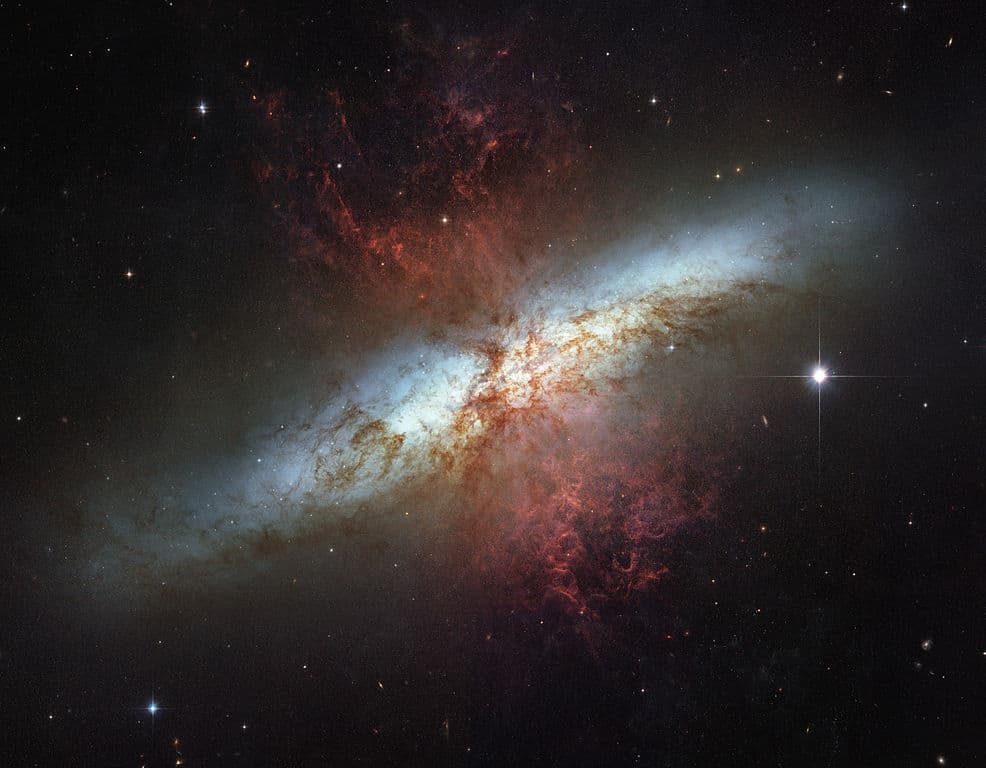
There are many other type of galaxies that exist or are discovered as you read this. With the advancement of technology, more and more distant or dim structures like galaxies can be observed and studied leading to an ever-growing classification.
Formation
Modern cosmological models of the early universe are based on the Big Bang theory. Around 300.000 years after the Big Bag, it is theorized that atoms of hydrogen and helium began to form.
This event is called recombination. At the time, most hydrogen atoms were neutral – non-ionized – and readily absorbed light. Density fluctuations in this primordial matter led to the creation of larger structures. As a result, masses of baryonic matter started to condense within cold dark matter halos. These primordial structures would eventually become the galaxies we see today.
Numbers
Most galaxies are between 1.000 to 100.000 parsecs / 3.000 to 300.000 light-years in diameter. Recent calculations of the observable universe suggest that there are over 2 trillion galaxies that contain an estimated 1×1024 stars.
Habitability
Probably the most powerful argument for life to exist elsewhere besides our Solar System is the sheer vastness of the universe in its unimaginable number of galaxies.
All of these galaxies contain innumerable stars, and these stars may contain innumerable exoplanets orbiting them. From this perspective at least, life should almost be guaranteed to exist somewhere else as well.
Future
Recently, a number of galaxies without dark matter were discovered. This could lead to a whole new type of galaxies, but overall, for the time being, it raises more questions than answers.
Did you know?
- Milky Way was classified as a spiral galaxy for a long time. However, observations only recently reclassified it as a barred type spiral galaxy.
- One of the youngest galaxies ever discovered was the I Zwicky 18 galaxy. It was estimated to be around just 500 million years old though recent observations have discovered old stars in this galaxy. Whether this galaxy is young or not is still debated.
- Sometimes nicknamed the zombie galaxy, MACS 2129-1 is a disk-shaped galaxy which spins twice as fast as our Milky Way. This galaxy hasn’t made any stars for around 10 billion years.
- One of the brightest galaxies in the universe is W2246-0526. This galaxy is “stealing” the mass of three nearby galaxies at once.
- Little Cub is a dwarf galaxy that remained dormant since the Big Bang. It might still contain unchanged molecules since just moments after the rapid expansion of the universe around 13.7 billion years ago.
- Most galaxies are being pulled by an unknown force named the Great Attractor.
Sources:
Image sources:
- https://upload.wikimedia.org/wikipedia/commons/thumb/8/85/Hubble_-_de_Vaucouleurs_Galaxy_Morphology_Diagram.png/640px-Hubble_-_de_Vaucouleurs_Galaxy_Morphology_Diagram.png
- https://upload.wikimedia.org/wikipedia/commons/thumb/2/21/HubbleTuningFork.jpg/583px-HubbleTuningFork.jpg
- https://en.wikipedia.org/wiki/Spiral_galaxy#/media/File:A_spiral_home_to_exploding_stars.jpg
- https://en.wikipedia.org/wiki/Elliptical_galaxy#/media/File:Abell_S740,_cropped_to_ESO_325-G004.jpg
- https://upload.wikimedia.org/wikipedia/commons/thumb/b/b7/Irregular_galaxy_NGC_1427A_%28captured_by_the_Hubble_Space_Telescope%29.jpg/681px-Irregular_galaxy_NGC_1427A_%28captured_by_the_Hubble_Space_Telescope%29.jpg
- https://en.wikipedia.org/wiki/Irregular_galaxy#/media/File:A_cosmic_optical_illusion.jpg
- https://cdn.eso.org/images/screen/eso0024a.jpg
- https://upload.wikimedia.org/wikipedia/commons/thumb/1/12/Artist%27s_impression_of_the_Milky_Way_%28updated_-_annotated%29.jpg/768px-Artist%27s_impression_of_the_Milky_Way_%28updated_-_annotated%29.jpg
- https://upload.wikimedia.org/wikipedia/commons/thumb/d/da/Hoag%27s_object.jpg/613px-Hoag%27s_object.jpg
- https://upload.wikimedia.org/wikipedia/commons/thumb/c/ce/M82_HST_ACS_2006-14-a-large_web.jpg/986px-M82_HST_ACS_2006-14-a-large_web.jpg
